
















CAN I WELCOME you to a magazine? It’s 2023 — why not? The February issue marks the beginning of a new year for Hospitality, and the team couldn’t be more thrilled to return after some serious eating and drinking over the festive period. I hope there was some time for you all to do the same.

We’re kicking things off with a look at Sydney kissaten Kahii; a venue that’s upping the specialty coffee game by day and serving a stellar French wine menu by night. We deep-dive into plant-based options across pastries, drinks and savoury applications and take a look at the boutique cider industry,
PUBLISHER Paul Wootton pwootton@intermedia.com.au
EDITOR
Annabelle Cloros
T: 02 8586 6226 acloros@intermedia.com.au
JOURNALIST Aristine Dobson adobson@intermedia.com.au
DISCLAIMER
which is seeing producers take a slow and steady approach, resulting in some incredibly sessionable drinks.
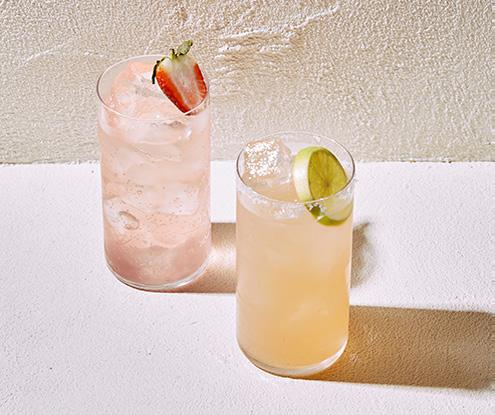
This issue, we also spotlight a group GM, a chef and a bartender on the latest happenings in their careers and profile Ramona’s Ashlee-maree Kent who is spearheading a trattoria that’s all about handmade pasta — yes, totally handmade; there’s not an extruder in sight. Until next time,
 Annabelle Cloros Editor
Annabelle Cloros Editor

ADVERTISING NATIONAL Simon York
T: 02 8586 6163 F: 02 9660 4419 syork@intermedia.com.au
GROUP ART DIRECTOR –LIQUOR AND HOSPITALITY Kea Thorburn kthorburn@intermedia.com.au
PRODUCTION MANAGER Jacqui Cooper jacqui@intermedia.com.au
CIRCULATIONS
To subscribe please call 1800 651 422. hospitalitymag azine.com.au facebook.com/ HospitalityMagazine twitter.com/Hospitalityed instagram.com/hospitalitymag
SUBSCRIPTION RATES
Australia:
1 year (10 issues) = $99.00 (inc GST)
2 years (20 issues) = $158.40 (inc GST) – Save 20%
3 years (30 issues) = $207.90
(inc GST) – Save 30%
SUBSCRIPTION RATES
New Zealand:
1 year (10 issues) = $109.00
Asia/Pacific
1 year (10 issues) = $119.00
Rest of World:
1 year (10 issues) = $129.00
This publication is published by Food and Beverage Media, a division of The Intermedia Group Pty Ltd (the “Publisher”). Materials in this publication have been created by a variety of different entities and, to the extent permitted by law, the Publisher accepts no liability for materials created by others. All materials should be considered protected by Australian and international intellectual property laws. Unless you are authorised by law or the copyright owner to do so, you may not copy any of the materials. The mention of a product or service, person or company in this publication does not indicate the Publisher’s endorsement. The views expressed in this publication do not necessarily represent the opinion of the Publisher, its agents, company officers or employees. Any use of the information contained in this publication is at the sole risk of the person using that information. The user should make independent enquiries as to the accuracy of the information before relying on that information. All express or implied terms, conditions, warranties, statements, assurances and representations in relation to the Publisher, its publications and its services are expressly excluded save for those conditions and warranties which must be implied under the laws of any State of Australia or the provisions of Division 2 of Part V of the Trade Practices Act 1974 and any statutory modification or re-enactment thereof. To the extent permitted by law, the Publisher will not be liable for any damages including special, exemplary, punitive or consequential damages (including but not limited to economic loss or loss of profit or revenue or loss of opportunity) or indirect loss or damage of any kind arising in contract, tort or otherwise, even if advised of the possibility of such loss of profits or damages. While we use our best endeavours to ensure accuracy of the materials we create, to the extent permitted by law, the Publisher excludes all liability for loss resulting from any inaccuracies or false or misleading statements that may appear in this publication. Copyright © 2023 – The Intermedia Group Pty Ltd
41 Bridge Road Glebe NSW 2037 Australia Tel: 02 9660
Average Net Distribution Period ending September 2019 – 11,506
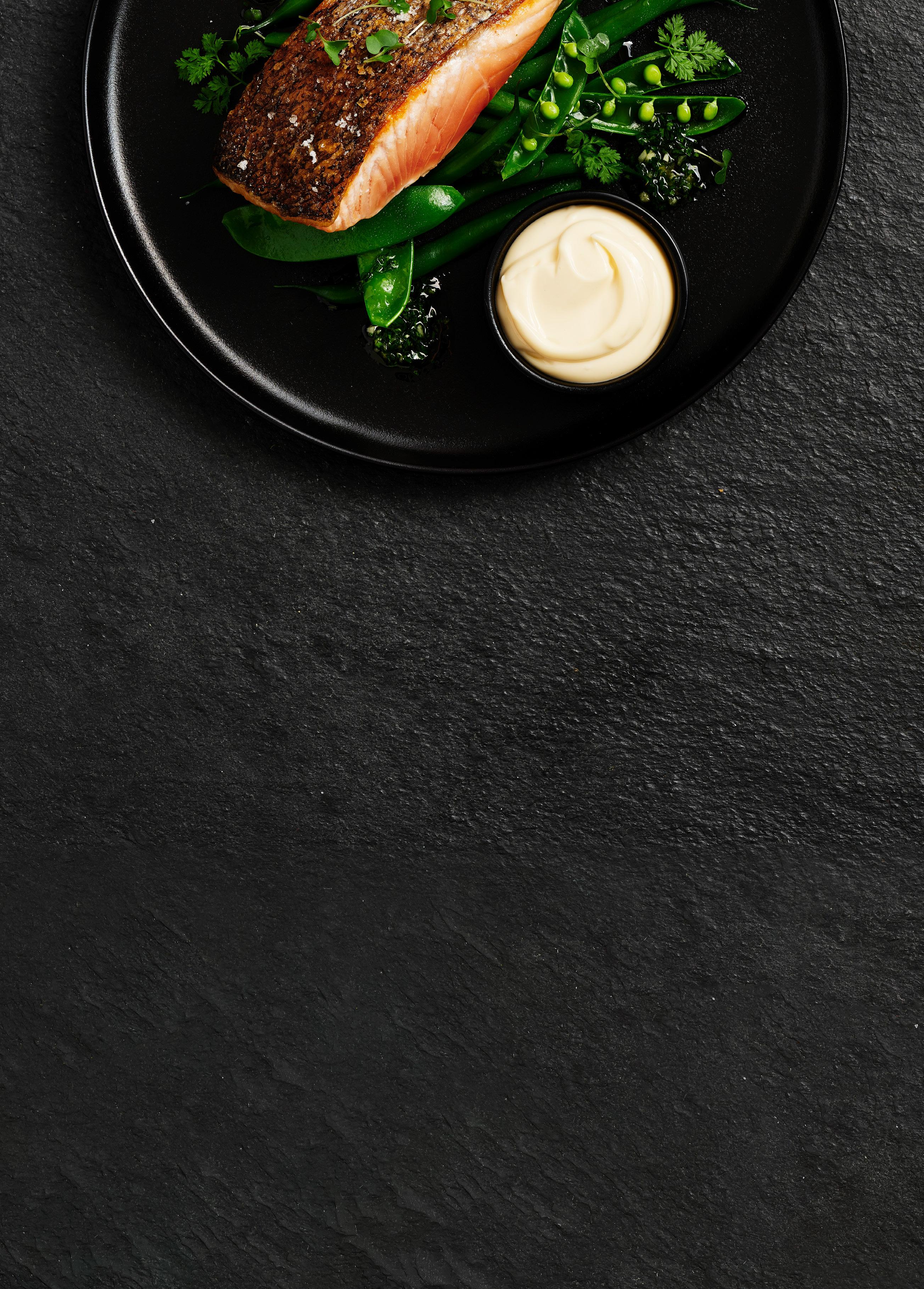






WORDS Aristine Dobson
PHOTOGRAPHY Hugh Davidson and Steven Woodburn
THE LORNE HOTEL has stood along the shores of the Great Ocean Road in Victoria for more than 145 years. When Merivale acquired the venue in 2021, there was much anticipation around how the group would change the historic landmark. The answer was a welcome surprise: the first interstate Totti’s, a concept that is synonymous on the Sydney dining scene for its puffy bread and pared-back approach to Italian cuisine.

Executive Chef Mike Eggert speaks to Hospitality in the lead up to the launch and runs us through the Lorne-only dishes that will highlight produce plucked straight from the waters in front of the restaurant.
Mike Eggert opened the first Totti’s inside the Royal Bondi back in 2018. The venue was an instant hit among Sydneysiders, who appreciated its laidback Italian-style fare and breezy alfresco dining area. The restaurant has remained one of the go-to eateries in the city, with three additional locations opening in the CBD, Three Weeds Rozelle and Allianz Stadium.


When Merivale purchased the Lorne Hotel in Victoria, the sale provided an opportunity for Eggert to get out of Sydney and explore a new market. “Justin [Hemmes] has got a great mind and knows what will work in certain areas,” says the chef. “He thought Totti’s would be successful and I think it’s a no-brainer. If you look at the way we do our food (that simple, minimal kind of thing) and the standard we set — and you think about this place as a holiday destination — it ticks a lot of boxes.”
The hotel’s location formed a key pillar of inspiration for the venue’s culinary direction. “We’re on one of the greatest coastlines in Australia with some of the best seafood, so we’re going to have a much stronger seafood offering,” says Eggert. “It will be the same old Totti’s everyone loves with the classics, but with a Mediterranean, coastal-Italian feel.”
Eggert is collaborating with the Lorne’s Executive Chef Matt Germanchis (former Movida) to develop the menu. The regional seaside location has given the pair the opportunity to work with local producers who reel in daily catches. “Most restaurants in large cities would struggle to have close connections with small producers,” says Eggert. “One of the advantages of being out on the coastline or further out from town is working where the produce is grown and where the fish is caught, so we’re directly linked to our locality.”


The chef is looking to use a range of seafood including albacore tuna, snapper, oysters, crab and different kinds of shellfish. Grilled seafood items are expected to be a hit among diners. “The real banging dishes will be the ones using seafood from the beach that will go over the coals and straight to the plate,” says Eggert. “That’s what’s really exciting for me and it’s what our customers will get excited about as well.”
Although the Lorne menu will look a little different to its Sydney siblings, some familiar dishes will make an appearance. The offering encompasses pasta, antipasti, mains, desserts, sides and of course the restaurant’s signature puffy bread which is fermented for 48 hours before being cooked in a woodfired oven. “We want people — it doesn’t matter if they’re in Bondi or Lorne — to be able to come and feel a sense of comfort and reassurance that they’re still able to order tiramisu or lamb pappardelle; they’re signature dishes for a reason,” says Eggert. “I’ve had the brand running for four years now and the top 10 dishes are always the same. We are absolutely bringing what we know the general public wants, but making sure it has its own Lorne voice.”
Totti’s is slated to open in late February and marks the first Victorian concept for Merivale, with Eggert keen to contribute to the state’s acclaimed culinary landscape. “It is our first foray in Victoria and we’ve employed 100 Victorians,” says the chef. “They are born-andbred hospitality people, so they know how to cook, pour drinks and wait tables. We’re stoked to be working with them.” ■

“We are absolutely bringing what we know the general public wants, but making sure it has its own Lorne voice.” Mike Eggert
 EDITED BY Amy Northcott
EDITED BY Amy Northcott
Sydney’s Darling Square has welcomed a new addition to its precinct with the opening of Irori Kuon. It’s the latest restaurant from the Kuon group, which also has a tempura eatery as well as two omakase concepts. Irori, which refers to a traditional sunken hearth used in Japan, celebrates the cooking technique of grilling over wood and charcoal, so expect curated cuts of meat, seafood and vegetables as well as larger dishes. kuon.com.au
Valentine’s Day gifting is sorted with Koko Black’s latest collection of bespoke boxes. Featuring a range of delectable truffles and pralines, there’s plenty of sizes to choose from plus personalised options for a special touch. The Valentine’s Day collection also includes the Love is Love boxes, which celebrate the diversity of love in conjunction with the upcoming WorldPride Festival and Midsumma Festival. Available in store and online. kokoblack.com

Melbourne’s Grossi Florentino has opened its doors once again for lunch and has launched a fresh new summer offering. You’ll find classic Grossi dishes alongside debut plates including Pomodoro made with heirloom tomatoes and buffalo mozzarella as well as aged Great Ocean duck with anatra arrosto and pickled plum. Lunch is served Monday to Friday from 12–3pm. florentino.com.au
Photography by Kate Shanasy
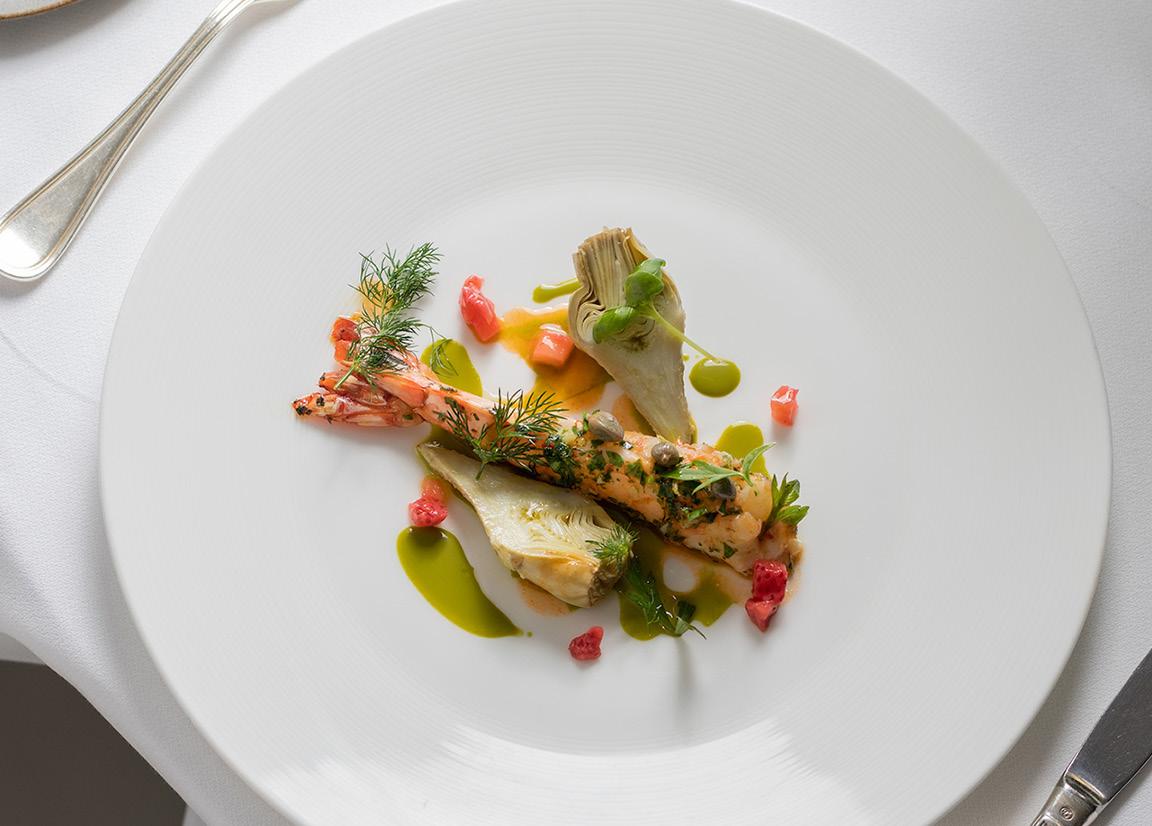


Rancho Seltzo is the latest concept from House Made Hospitality, which has teamed up with Bondi Brewing Co. to launch the Bondi venue. The summery space is located on the ground floor of Pacific Bondi Beach and evokes the ultimate holiday feeling, serving up resort-style summer drinks including seltzers, frozen Palomas, iced tropical whips and seltzer spiders. Executive Chef Elliott Pinn has put together a menu inspired by the Mediterranean, plating up dishes such as kingfish ceviche with coconut and crispy flathead with spicy cabbage. ranchobondibeach.com
Photography by Steven Woodburn
Christopher Thé of Black Star Pastry fame is venturing into the café game with a new establishment in Sydney’s Inner West. Based in Stanmore, Hearthé showcases native Australian ingredients in a modern setting via a range of sweet, savoury and vegan options. Expect to see a collection of Thé’s Signature Native cakes alongside pastries, house-made breads and baguettes and a daily, slow-cooked dish inspired by local produce. hearthe.com.au
Noma 2.0: Vegetable, Forest, Ocean


René Redzepi, Mette Søberg and Junichi Takahashi
Hardie Grant Books ; $130
While Noma will close its doors after completing its winter season at the end of 2024, you can venture beyond the pass at your leisure and explore the process behind some of the most inventive dishes the culinary world has ever seen in Noma 2.0: Vegetable, Forest, Ocean . The book covers the creative thought process behind 200 dishes served at Noma, with each creation accompanied by a QR code that takes readers to the complete recipe used by the kitchen.
From the minds behind The Sunshine Inn and The Little Guy, aka Dan McBride and Dynn Szmulewicz, the Enmore Country Club is a new neighbourhood bar that’s taken up residency on Enmore Road in Sydney. The charming 60-seat bar is a lively take on a country club and features a retro aesthetic concepted by Doom Juice Creative Director Zachary Godbolt. Guests can sip on natural wines from an ever-changing list along with local beers and cocktails including the venue’s signature hard cherry cola. enmorecountryclub.com
Photography by Angus Bell Young
PURCHASE A 3 X 2KG OR 2 X 6KG CARTON OF CABOOLTURE SHREDDED MOZZARELLA CHEESE FOR YOUR CHANCE TO DISCOVER A GOLDEN TICKET VALUED FROM $1000 TO $20,000!
HOW TO CLAIM: FIND A GOLDEN TICKET, TAKE A PHOTO AND SEND IT, ALONG WITH YOUR INVOICE TO AUS.FOODSERVICE@SAPUTO.COM


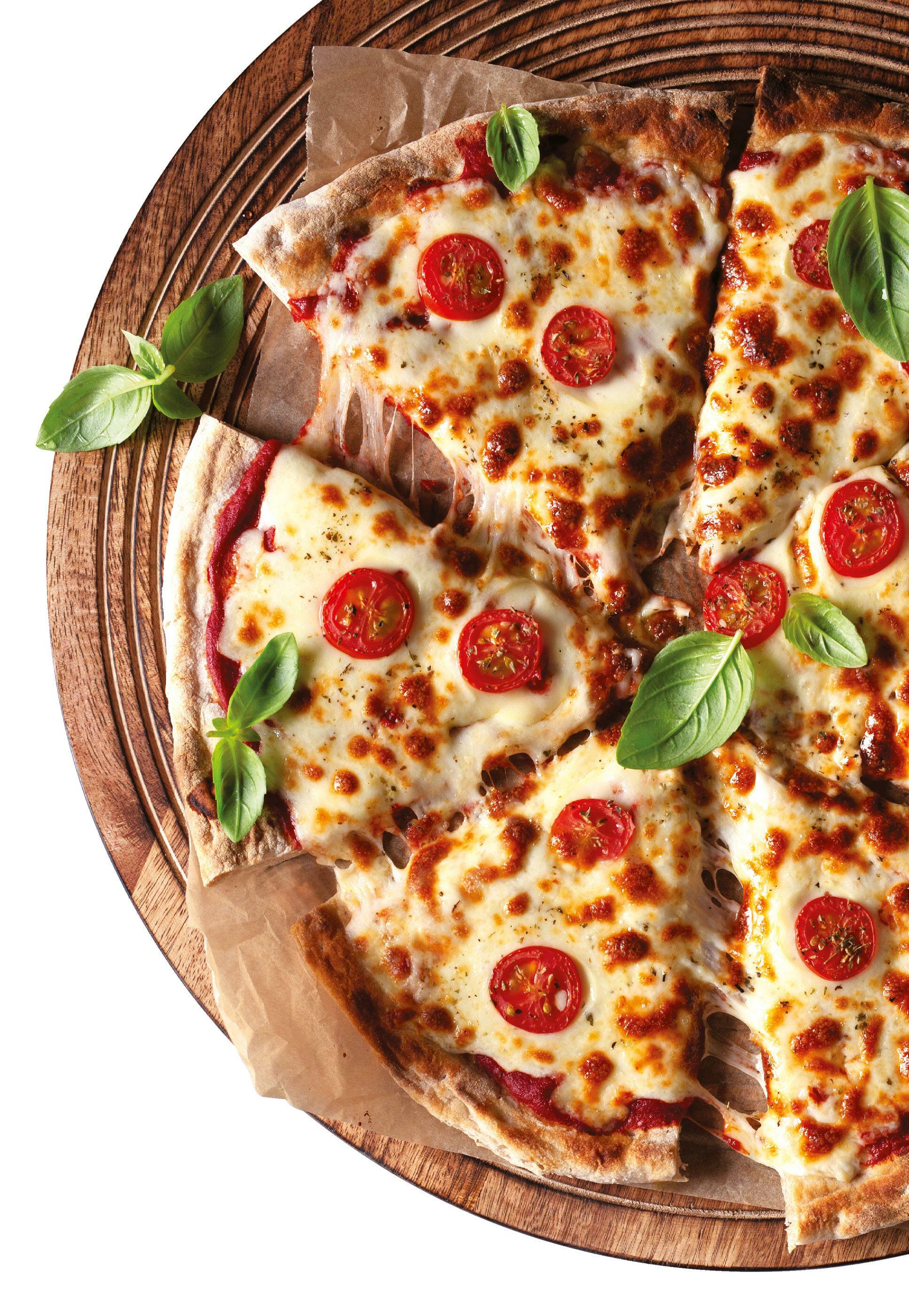
THE INDUSTRY MUST deal with labour shortages, inflation, high interest rates and ever-changing food trends. But so do your competitors, and eating out is always popular. People will adjust their budgets and choices, and you’re flexible enough to meet them with fresh new offers. Here’s a 2023 hit list to stay ahead of the curve.

Double down on customer service, removing friction and delays. Part of this is a boost to staff training: start with tray skills and simple sales scripts, then find ways to make service faster. Upgrade your use of QR code ordering and digital menus — it’s easy tech for most visitors and always leads to an increased average customer spend.
Upgrade your menu. A digital menu gives you endless flexibility to experiment with new dishes, drinks and pricing. If something doesn’t work, it’s gone in minutes, or you can raise the price if it’s a success. Your kitchen team will be looking to experiment — give them access to menu software to cost and develop specials and use Instagram to promote them.
Strengthen familiar and popular menu items. When people are uncertain, they’re after familiar favourites (at least eight out of 10 want the same as last time), so make sure these dishes are high quality and priced with a winning margin.
Use technology to free up your time. If you’re already using online rostering and booking services, integrate them with bookkeeping, payroll and marketing. Make 2023 the year for taking tech to the next level. Recipe costing works hand in
and starters. Use the AI power of online rostering to match rosters more accurately with customer numbers and fine-tune your payroll processing.
Watch your numbers. It won’t take long to find hidden money when you have time to spot-check bills and negotiate with suppliers. Basic bookkeeping work can be done by someone else. Your role should be looking at weekly reports, tracking trends and responding decisively, not hunched over 200 Xero entries that don’t want to reconcile!
hand with a kitchen system that manages ordering and flags unexpected price rises. Unlock the power of your booking service by taking more deposits to guarantee attendance, automatically turning feedback into Google reviews and pre-selling drinks
Put extra strength into marketing, which might just mean being consistent. Post on Instagram and Facebook at least five times per week and send a monthly email to your database of customers you’ve built up from booking and functions systems. Create content by experimenting with ChatGPT. I asked it to create ideas for a series of six monthly email newsletters for an Italian restaurant. It provided information about regional ingredients, wine recommendations, travel highlights, cultural traditions and Italian phrases for eating out and wrote each one.
Stay positive: economic challenges can lead to so many new opportunities, and your competitors will look on with wonder. ■
Your kitchen team will be looking to experiment – give them access to menu software to cost and develop specials and use Instagram to promote them.
COMPETITION IN AUSTRALIA’S dining industry is high. The Australian Bureau of Statistics published September 2022 quarter retail spending results that showed cafés, restaurants and takeaway food services had a 3.3 per cent quarterly volume rise.
When comparing spending to the same time last year, the Australian Retailers Association (ARA) recently published that: “As we continued to cycle the Delta lockdowns of 2021, there were substantial year on year sales increases across all categories…[with] cafés, restaurants and take away food up 52.6 per cent...”
One point the ARA raised was that “overall trading conditions continue to be challenged by supply chain constraints and staff shortages with vacancies continuing to be at record levels”.
One of the core workhorse technologies helping to support all kinds of digital systems inside dining outlets is cellular broadband.
Food outlets and retailers are increasingly opting for cellular networks to power POS terminals and in-store video surveillance cameras, or as failover (backup connection) because of the

increased reliability and flexibility that cellular provides.
Food outlets that utilise pop-up stalls at markets, vending machines or interactive kiosks know that establishing wired connections can take months and is very expensive. In contrast, obtaining cellular connections can be done in days. Moving a landline from an existing location often involves huge expenses, time and effort compared to cellular connectivity.
For stores wired by landlines, interruptions such as a construction mishap or weather events can take down a connection. Turning customers away during the holidays because a POS system suffers a glitch can be hard to come back from, especially after the ongoing interruptions to the dining sector over the last few years. To eliminate some of this risk, employing network diversity can be helpful.
During busy periods, food retailers can choose to practice something known as router redundancy. Say for example, a business that operates during evening hours experiences an outage at night to its landline connection. If it’s the store’s only connection, it’s out of luck. Chances are tech-support staff are off-duty.
An additional cellular router used as a backup or failover solution can enable staff to keep operations humming and
customers happy. This kind of redundancy is also handy when maintenance must be done. When calculating the cost-benefit ratio of a second router, food retailers should also consider the additional number of already stretched staff that would be required to manage a dinner service when payment or digital ordering systems are down.
Anticipating how the dining retail sector will evolve isn’t easy. In the near-term, restaurant owners are focused on recovering from the past three years and navigating the slumping economy.
Meanwhile, whether a food outlet wishes to create new interactive digital experiences, implement new tech tools to boost operational efficiency or simply ensure its internet connection has redundancy, the need for cost-effective, high-speed connectivity will continue to rise.
There’s also the emergence of 5G to consider. The fifth generation and most recent technology standard for broadband cellular networks continues to get rolled out by the major carriers across Australia and those merchants that acquire the most experience using 5G may be the ones that map the course of the industry’s future. ■
Visit cradlepoint.com/au



THIS IS A story about minimal-intervention cider — with Fin Wines. Don’t let the name fool you, the Dixons Creek producers in Victoria have made cider from the jump, taking an approach that lets nature do its thing. While natural wines are now part and parcel of the drinks landscape, the same can’t be said for its oft-apple-based counterpart — yet.

Fin Wines are part of a growing number of local makers making ciders the way they should be — complex, thought-provoking and nuanced. Hospitality speaks to Director JonJo McEvoy about the status of grass-roots ciders, the production process and why consistency isn’t key when it comes to making a crushable bevvy.
Fin Wines is found on the lands of the Wurundjeri people of the Kulin nation. The self-described fermentation collective comprises JonJo McEvoy, Oliver Johns and Angus Hean, who came together to create a brand born out of a love of tasty wines and ciders. Fin Wines launched its debut range of wines, ciders and piquettes in January 2020, going on to secure a 10-acre farm and vineyard one year later.
The ‘Finyard’ was planted in the early ’90s on grey–red sandy loam over clay, and has long been farmed without any nasties, with the trio maintaining the same approach since taking over. Biodiversity is big here, as it should be.
And so is cider. “Cider was our first product and I’m originally from the West Country in the UK, so I grew up drinking it ... especially some of the more natural styles,” says McEvoy. An opportunity to source organically grown fruit from McEvoy’s business partner’s family orchard presented itself, and it was a natural fit for both parties, which share a hands-off ethos. “They used to grow fruit for the supermarkets, but the contracts fell through. When you’re not
so worried about having a presentable apple, you get a thickening of the skin which creates tannins and depth of flavour. It’s very minimal in the farming, and very minimal when it comes to the winery.”

Everything from apples, grapes, plums and pears to cherries, elderflower and “whatever we can get our hands on”, informs Fin’s everevolving cider range. The majority of the produce comes from growers in the Yarra Valley including CherryHill Orchards, Box Grove Vineyard and Yering Farm, with everything else sourced from connections or social media. “Most of the time, we’ll get a call from someone saying they have apples or cherries,” says McEvoy. “Or I will see a post on Instagram about something being available and we will think, ‘That would make a cool drink’. We think about the drink first rather than it being based on a particular fruit and try to play around with people’s perceptions of what they expect from a beverage made from that certain fruit.”
The cider-making process is as no-frills as it can be. Apples are sorted and cleaned with water before being milled and left on skins for one to three weeks, which “kickstarts the wild ferment and creates depth of flavour,” says McEvoy. “You also get a nice tannin profile depending on the apples.”
The fruit is then layered in between wooden racks in a “really manual” cheese press. Rack and cloth pressing is a traditional method of cider-making, resulting in better extraction compared to wine presses, which aren’t effective at juicing fruit such as apples.
The liquid is pressed directly into buckets before being funnelled into barrels and left to ferment alone or with co-ferments such as grape skins and grape juice. “We don’t use any preservatives about 95 per cent of the time,”
cellar door is open on weekends
Grape skins and juice are added to select ciders
Cherry cider is sold in cans and bottles
Fin sources apples from an organic orchard

says McEvoy. “Everything is fermented dry and it’s a real labour of love. It normally takes between three and six weeks to finish the ferment, and we also play around with leaving stuff in the barrel for extended periods of time. We have done up to three years, and that’s when you see tertiary notes that result in complex ciders. Our fresher ciders are in barrel for a year.”
Fin’s cider range is haphazard — in the best way. Many products come about through innovation, imagination or sheer coincidence. “The Roussane happened because some of the barrels were very cider-esque already, so we combined apples with the wine,” says McEvoy. “We had a Pinot Gris one year with lots of nice primary flavours from leaving it on skins and the carbonic maceration, so we thought it would be good in a cider with some cherries because it had a lot of berry flavours.”
The Roussane was a sellout for Fin, with the team struggling to keep up with demand since launch. “We will try to make it a staple, but it’s not a huge batch,” says McEvoy. “Our smallest batch is 100L, but we do about 2–3000L for our canned range.”


The dry cider is part of the canned range, which sees a 20:80 ratio of one-year-old cider combined with freshly pressed juice. The team recently switched up production and put the fresh juice into steel for five weeks before moving it to another tank and adding in the aged cider. “We re-fermented it in the can with residual sugar,” says McEvoy. “The idea was to create something that was super approachable ... like biting into a fresh apple.”
Drinkers can expect to see Riesling come into play soon, too. “I want to put some of the cider on Riesling skins from our vineyard,” says McEvoy. “Something to give it some floral flavours.”
The cider sector is currently dominated by mainstream makers, which means a large portion of drinkers associate it with sugar — which is a positive for some, and a hard pass for others. But boutique producers are slowly educating the public on the nuances of cider and opening their eyes to its complex nature. “I think there’s an abundance of bad ciders and that’s people’s only experience of it,” says McEvoy. “It’s a bit of a difficult market because there’s not a lot of people who drink this style of cider, but it’s definitely growing, which is nice to see. When we do tastings at the cellar door, I always open ciders and trick people into drinking them and they become converts — it’s pretty obvious they just haven’t had a good cider before.” Thankfully, that’s now changing one bottle (or can) at a time. ■

“We think about the drink first, rather than it being based on a particular fruit and try to play around with people’s perceptions.”
– JonJo McEvoy
Thirst quenchers, slow sippers and all things beverage related.
 EDITED BY Annabelle Cloros
EDITED BY Annabelle Cloros
Champagne house Mumm has collaborated with Pernod Ricard winemakers to create a sparkling wine that showcases Tasmanian grapes. Mumm Tasmania is the latest addition to the Mumm Terroir Series and is a new expression of Pinot Noir. The sparkling has been made according to the methode traditionnelle process and features aromas of warm spices and red berries. Available nationally for $40 from liquor retailers. mumm.com

Oakridge Wines and Chapel Hill have come together to give piquette its much-overdue moment with the launch of two products. The wine-esque/ spritz beverage is made from pomace, which is traditionally considered a by-product. Sangiovese grape skins or Pinot Gris grapes are combined with water, botanicals and wild yeasts before undergoing two fermentation processes. Escape Room features notes of blood orange, raspberry, cherry and cranberry while Garden Gris is a little heavier with pomegranate, red cherry, apple and spices. $7.99 per can or $29.99 for a four-pack. danmurphys.com.au
Canned cocktail connoisseurs Curatif don’t skip on the R&D phase, with its latest product requiring months of testing before it was deemed just right. The spicy margarita is a riff on a Tommy’s and has a base of Tequila Tromba blanco teamed with Australian lime juice, agave nectar and a combination of four chillis: ghost pepper, Trinidad Scorpion, Carolina Reaper and habanero. The cans come in a four-pack for $45. curatif.com


Daily Iced created the Puddle cup out of necessity: lots of reusable options, but not many designed for iced lattes. Enter Puddle: a BPA-free cup with dual-wall insulation designed to fit under any café’s coffee machine. Puddle has a maximum capacity of 345ml and features a screw-on leakproof lid, so there’s no risk of losing your drink. It also comes with a straw and an oh-so-cute ice cube mascot on the front. $39.99. dailyiced.com

Liquor distributors Bibendum Bar are getting into the mixer market with the launch of a new range. Midnight Mixers covers five options that are designed to pair with highquality spirits. The collection covers classic tonic, extra dry tonic, bitter lemon, ginger beer and soda water, with each made in collaboration with a UK-based flavour consultant. The complete set includes 24 200ml cans for LUC $39.50 and is available from bibendum.com.au
The former fine-dining chef is crafting pasta by hand at her Brisbane trattoria.



WORDS Aristine Dobson
PHOTOGRAPHY Jess Kearney
MAKING PASTA FROM scratch is a deceptively simple process that’s nothing short of a labour of love — especially in a restaurant setting. At Ramona Trattoria in Brisbane’s Coorparoo, Owner Ashley-maree Kent forgoes extruders and produces almost every pasta shape by hand. The chef has long had an affinity for dough-based creations, honing various applications in some of the most reputable kitchens in Australia and overseas — think Quay, Tartine, Biota and Paper Daisy, to name a few.

Kent speaks to Hospitality about going to and from fine dining to baking, opening her first solo venture and taking a hands-on approach to each and every dish served at her suburban trattoria.

Ashley-maree Kent grew up in Bowral in the Southern Highlands in New South Wales and spent the early part of her career in Sydney. After completing her apprenticeship, the chef worked at Quay before joining Merivale. “I jumped between Felix, Uccello and Est.,” she says.
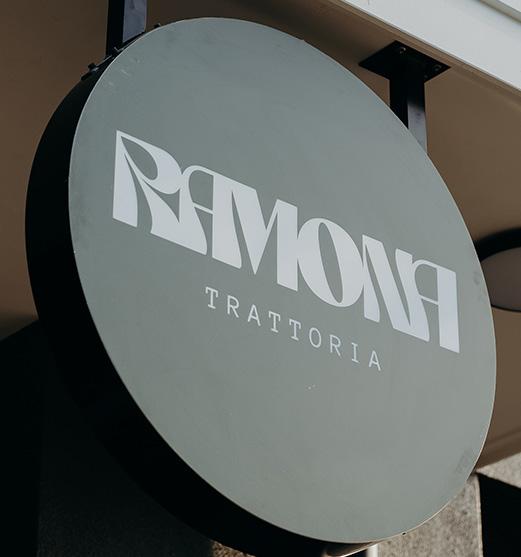
Kent decided to expand her skillset after two years with the group, going on to work in the kitchens of the now-closed Greek restaurant Xanthi and The Morrison Bar & Oyster Room. “I always found myself wanting to have a piece of each pie to gain experience, and I thought it would be best to learn a little bit of everything,” she says.
The chef later decided to take a step back from fine dining and work at Iggy’s Bread. Just six months later, she was approached by Nathan Sasi to join Nomad. “They needed someone to do the bread section, pastry prep and the charcuterie,” says Kent, who was brought on as chef de partie. “I’d start at 10pm when the oven was still hot from service and I’d work until about eight or nine o’clock in the morning, which was tiresome, but it was a good experience.”
Kent returned to her hometown to join James Viles at his renowned fine diner Biota. The position had a lot of appeal, not
just because it was close to home, but because it provided an opportunity to learn more about sourcing and growing produce. The gig allowed Kent to do a bit of everything, fast expanding her skillset. “We were a small team and got to move around a lot in the kitchen,” she says. “You might be on pastry one day, then garnish or meat. Everyone was cross-trained and there was a very personal and family oriented vibe.”
After a year, Kent planned to work at the now-closed Manresa in Los Gatos, California, but a kitchen fire resulted in a change of plans. “I already paid for my green card, accommodation and flights and didn’t want to waste them, so I started calling a couple of friends,” says the chef, who secured a position at Tartine Bakery in San Francisco instead. Tartine was a small operation at the time, with its heritage loaves, pastries and rustic-style sandwiches soon becoming globally acclaimed. “We were doing a lot of products with our hands,” says Kent. “I did everything from dough mixing and shaping to loading the ovens and scoring.”
Upon her return to Australia, Kent went back to Biota before joining Three Blue Ducks in Sydney’s Bronte. When the group launched another location in Byron Bay, Kent relocated to join the opening team and worked her way up the ranks. “I ended up going from sous chef to head chef pretty quickly,” she says. “It was my first head chef role. I was in charge of 26 kitchen staff and doing upwards of 1,200 covers a day.”
Although Kent was hitting her stride at Three Blue Ducks, she returned to Biota as
co-head chef, with her final role coinciding with five years spent at the fine diner. “It was a place I could always go back to and be welcomed as if I never left,” she says.
It has now been almost six years since Kent moved to Queensland after spending the bulk of her cooking career in Sydney. “I didn’t want to work in the big smoke anymore and do so much fine dining,” she says. “As soon as I made the move to Queensland, I got a job at Paddock Bakery
meticulous,” she says. “I guess it is ingrained when you do it for that long.”
Stints at Alex Munoz’s Labart and a wine bar called Tasca followed. “The owners of Francie’s in Coolangatta ended up buying Tasca and we turned it into Cross Eyed Mary, which was a hand-shaped pasta bar with wines and a small food menu,” says Kent.

The chef opened the doors to the new concept during the pandemic, using the time to become acquainted with pasta. “I started getting into pasta-making and doughs in general and then it became a passion thing,” says Kent. “I did a lot of research and spent a lot of my free time teaching myself how to hand-shape pasta.”
The newfound skills were put to good use after Kent’s departure from Cross Eyed Mary. “Unfortunately, the partnership wasn’t going the way I wanted it to,” says the chef. “I was approached by Tom [Torchut] from Tommy’s Italian to be a consultant for pasta after I left Mary.”

where I was just doing bread production.”
Kent was in her element at the Burleigh Heads bakery, with the job rekindling her love of working with dough. “You get more and more passionate the more you do these things,” says the chef. “I thought, ‘Maybe my passion is doing bread?’”

But staff changes at Paddock prompted Kent to resign and return to fine dining, working at Ben Devlin’s Paper Daisy. “I did expect I would go back to fine dining, plating with tweezers and being
Kent later decided to embark on her first solo venture: Ramona Trattoria. “I wanted to open a restaurant and do my own thing because I was kind of over working for other people,” she says. “While I was working full-time, I was planning, designing and constructing Ramona.”
The dream was finally brought to fruition when Kent signed the lease for a location on Leicester Street in the residential area of Coorparoo. The Italian concept had to stand out from the get-go and deliver something truly unique to the dining scene. “There are so many Italian restaurants opening and I was like, ‘Am I going to be another Italian restaurant in
“I want a local person to come in and I know them by their first name.”
Ashley-maree Kent
Brisbane or am I actually going to have a point of difference?’” says Kent. “The space was a little bit too big for just pasta so I thought, ‘Let’s incorporate anything dough-associated’.”
The name Ramona means wise protector in Spanish, which speaks to the venue’s core ethos of preserving food traditions. Each dish is curated with care and has simplicity at its core. “A big part of our culinary direction here is being minimal,” says Kent. “We take a lot of time with the small things and we make it quite simple.”
The offering centres around dough-based dishes such as pizza and bread along with antipasti and dessert. But the main drawcard is the hand-shaped pasta, which Kent and her team spend upwards of four hours making every day. “I think it connects you to what you’re serving instead of buying packet pasta or putting semolina and flour into an extruder,” says the chef. “You learn to look after your produce a bit more and have respect for it.”
While the kitchen is equipped with tools such as cutters, knives, chitarras, rolling pins and gnocchi boards, there is not an extruder in sight. Kent is adamant on producing everything by hand and believes the final product is unparalleled. “We make the dough by hand, shake it by hand and roll it out,” she says. “Our hands don’t work the same way as a machine, so when we’re kneading pasta, it takes up to eight minutes to get the texture we want. It’s a lot of labour, but I believe it’s worth it.”
Kent has trained her whole team on the art of pasta-making and switches up the menu to keep chefs engaged. “I change the menu every six weeks because I don’t want people to be stagnant,” she says. “Imagine doing six pasta


dishes five nights a week … you’d get bored.” When it comes to pasta, Ramona serves everything from fettuccine and spaghetti to ravioli and tortellini. Each shape is paired with the right sauce and there is no room for swaps or substitutions. An example is the tagliatelle alla Bolognese made with a traditional-style ragu that uses various off-cuts and proteins for added flavour. “There’s different types of charcuterie, pork mince and veal mince that goes into it,” says Kent. “The sauce is very brown and is quite rich from chicken livers.”
Kent tips the tortelloni burro e oro as a mustorder. The dish is a staple in the Italian region of Bologna and is known for its sauce which combines butter and tomato. “We do a very simple sauce which is basically tomato sugo, but it’s done with San Marzano tomatoes that have been crushed with our hands,” says Kent. “The sauce is yellow and chunky at the same time.”
Ramona Trattoria has been open for six months now and has stirred up plenty of interest from diners near and far since it launched. “A lot of the feedback I get is [that people can never get a seat] because it’s not just locals coming here,” says Kent. “We’ve got people from the city, the Gold Coast and other states coming in.”
The chef is content with the restaurant’s progress and has well and truly settled into the neighbourhood. “I’m not interested in the city — I’m interested in the suburbs,” she says. “In the city, you’re probably always going to be busy because there’s so many people going in and out, so you don’t always have return customers who come in twice a week. That’s the clientele I want for this restaurant. I want a local person to come in and I know them by their first name.” ■
The restaurant’s wood-fired ovens were built by @thebrickchef
Sam Vescio
Kent originally wanted to be an aeronautical engineer
Ramona Trattoria seats 48 diners
Fresh pasta takes up to four hours to make

Your invitation to join Melbourne’s newest retail destination: The University of Melbourne’s Parkville Campus.

This new precinct, located on the corner of Grattan and Swanston Streets, at the new heart of the Parkville Campus, provides a place for students to engage, connect and play. It delivers new and refurbished buildings, extensive landscaped spaces, arts and cultural theatres and event venues, 3500 study seats, and a substantial food and beverage (F&B) offering.
This industry-leading retail precinct brings together services, events, activities, and new retail opportunities that create a vibrant centre of activity on the Parkville Campus.
It is the new place to engage creatively through the arts, to unwind, to study, connect and innovate in spaces designed to enhance the student experience. Laneways and spaces for dining and social interaction are positioned along high-traffic pedestrian routes, offering a mix of fast casual dining,
*Approximate
quick service restaurants, ‘grab & go’, and cafés, while the retail offering is centred on convenience and daily essentials.

Activated in a staged approach, the new retail precinct currently boasts a multitude of market leading hospitality brands and operators, including St Ali, AU79, Zambrero, PappaRich, Moonfishh, Thailander, Rice Workshop, Gong Cha and many more, creating a vibrant food and hospitality destination for the University cohort. Modern University precincts are not complete without the inclusion of an attractive social space for casual dining and responsible drinking, and the vision for the Student Bar & Eatery will round out this curated F&B mix.
Located on the first floor of the newly renovated building 168, in close proximity to the Student Union and study spaces, and with easy patron access via Swanston Street, this outlet is destined to become a central feature and will deliver a distinctive F&B offer, set alongside the present F&B mix.
The University’s ambition for the first-floor space is to partner with a forward-thinking hospitality operator who can devise a bespoke concept to establish a unique point of difference for the precinct, encourage a safe and social environment for students and provide an affordable ‘student offering’ of alcoholic and non-alcoholic beverages and delicious food.

We aim for this business to become a focal point of and an iconic part of campus experience and are open to hearing from reputable operators as to their vision for a concept to activate this space.
For more information on this fabulous opportunity, contact Adam Lester, at Colliers for a confidential discussion.
Direct: +61 3 9940 7239
Mobile: +61 432 097 599
Adam.Lester@colliers.com
Secure your place at the University of Melbourne’s world-class Parkville Campus today.
SYDNEY IS A city that sticks to a schedule. Cafés open by 7am and lunch spots start serving around 11:30am. Both venues are usually done and dusted by 4pm — otherwise known as the shift change — the time where it is almost impossible to get a decent cup of coffee. Global destinations are a little less rigid when it comes to structure, and local venues are beginning to offer a more flexible offering that can morph with patrons throughout the day.
Enter the kissaten — a space that is less café and more coffee shop. The Japanese concept took off during the Showa era, with the tea-drinking rooms complete with record players spinning LPs. As time went on, kissatens evolved into more specialised places, with some paying homage to jazz and others coffee. The kissaten had its boom before mellowing out in prevalence and popularity as foreign coffee chains entered the Japanese market. But what’s old is new again, and the classic kissaten has reemerged under operators who are casting a modern lens over the staple.
Global takes on kissatens can be found in London, New York, and Sydney — of note is Kahii. The Japanese-inspired CBD café specialises in coffee, matcha and boutique pastries during the day before morphing into a wine bar in the evening that serves oldworld French wines and dishes from neighbouring fine diner Kuro.




Hospitality speaks to Kahii’s Kei Tokiwa and Edmond Loo
about sourcing green beans and roasting in-house, mastering matcha recipes, filling the 3-5pm gap in the market for coffee and switching into night mode.

Kahii’s modus operandi is two-fold. Specialty coffee is the first prong — and arguably, the backbone of a kissaten, but there’s a little more to it than that. “A kissaten is not just based on coffee, it’s a stop for salarymen before they go to work,” says Consultant Kei Tokiwa. “They go for a quick bite, a cup of coffee or something to drink. In a nutshell, it’s a café that really helped the economy back in the day and it’s where a whole workforce would hang out. Kahii is our take on kissaten culture and replicates the idea in a space that’s moody and intimate.”
Thanks to its Kent Street location, CBD workers comprise much of Kahii’s customer base, which presented an opportunity for CoOwner Edmond Loo to establish a bespoke coffee offering which sees up to four single origins available at a time alongside a house blend. Loo sources green beans from monthly cupping sessions, going on to roast them at various facilities around Sydney. “Kahii is pretty much an overhaul on specialty coffee,” says Loo. “I’m quite liberal with the beans I procure, and we push everything equally, so the customer has a variety of specialty coffee.”
Kahii’s house blend Gatsby is a combination of beans sourced from Brazil and Colombia, with Loo working with companies that specialise in each location. “The blend is quite stable, and we need two green beans that are available all year round,” he says. “Essentially, I have created a recipe to bring out the better characteristics of what each bean can provide.” Gatsby has notes of dark chocolate, toasted almonds, raisins and “occasionally butterscotch”, with the blend becoming an instant crowd-pleaser among an older generation of coffee drinkers.
But there’s something new in the works for those who prefer a fruitier flavour profile. “There are more younger people around, so I’m roasting another house blend that’s catered to people who are more involved in the third wave of coffee,” says Loo. “The recipe has a 50:50 ratio of beans from Ethiopia and Colombia and gives me a more aromatic cup of coffee.”
A seasonal approach is naturally as relevant for coffee as it is for food. Kahii switches out its roster of single origins in line with availability and application. For example, Kenyan beans have recently been used for drip and Colombian beans for iced batch brew. “It all depends on the apparatus I’m using,” says Loo.



Matcha’s presence and popularity continues to grow, with various beverages becoming commonplace at a range of cafés. Kahii works with Simply Native in Surry Hills to source its matcha, with the team participating in tastings to sample different grades of matcha before selecting the best option. “We have settled on a high-grade powder that’s not ceremonial because we run it through milk,” says Tokiwa. “Ceremonial-grade matcha tends to be too delicate in terms of flavour, so we needed something that would hold up through the process of warming up milk [and against] oat milk, too.”
Kahii’s matcha latte took months to develop, with everything from region to weight taken into consideration. “We do a lot of recipes,” says Loo. “The roast degree of the matcha and the region are factors in terms of grams. You need a darker roast to cut through milk, so it ends up being a little bitter in the finish, so we whisk in honey with the matcha powder so it has balance. The honey we use doesn’t have any eucalyptus in it; it’s quite mellow and doesn’t take away from the flavour of the matcha.”
While some start their day with a matcha latte, others prefer it as an afternoon-slump solution — and the same goes for coffee. Kahii keeps its coffee machine on until 5pm on weekdays (except Monday when the venue closes at 3pm). “We find most cafés in the city close around 3pm,” says Tokiwa. “But people have a more flexible work schedule now or they might finish work later. There’s also the hospo crowd who work nights and probably don’t get up at 8am for coffee. The aim is to fill that need for a great cup of coffee and we will run the café later in the future if it all goes well.”
“I’m quite liberal with the beans I procure, and we push everything equally, so the customer has a variety of specialty coffee.”
– Edmond Loo
But come 5:30pm, it’s time to get into some wine — French wine, to be specific. Co-Owner Alan Wong is a big fan of drops from Burgundy, which go hand in hand with sister venue Kuro’s French–Japanese culinary direction. “We wanted to introduce guests to classic old-world wines as well as focus on smaller houses that you would find in fine-dining establishments as opposed to standard wine bars,” says Tokiwa. “We are also looking at the Jura region which is quite trendy at the moment and have about 20 per cent newworld wines on the menu.”
Drinks come first at the wine bar, with Kuro’s Executive Chef Taka Teramoto designing the menu around the wine offering. Plates span Appellation oysters with rhubarb mignonette “which is the first thing a guest would get, so we match it with something chalky and creamy like a Cremant”, says Tokiwa as well as the drinkfriendly snack of saltbush tempura with cocktail sauce and yukari.
Kahii is located in the Heritagelisted Kelco House
The bar serves a boutique range of sake
Pastries from Tenacious Croissant are on offer during the day
Burgundy wines take pride of place on the wine list
Champagnes are prevalent on the drinks menu, with organic and biodynamic producer Larmandier-Bernier listed alongside other grower Champagnes. “We’ve also set up the Burgundy list from north to south in terms of the regions and appellations and are looking for the best-in-house producers,” says Tokiwa. “If we hear about a smaller house, we’ll look into it. We do have a variety of clients coming in, so the younger crowd tends to go for more high-acidity styles such as a wine from Katsunuma Jyozo Winery in Japan, while the older crowd goes for the classics.”
Kahii also carries a small selection of sake, which is the recommended pairing with sashimi, while a dry Riesling or light Gamay works with the 2GR Wagyu tartare topped with egg yolk jam and anchovy emulsion. Larger plates are available for those looking to make a meal out of it, with the protein-centric dishes covering roasted cod with beurre blanc; 16-day dry-aged duck with red wine and leeks and MB9+ Blackmore Wagyu with potatoes. “The duck goes with a Pinot from Burgundy and the fish with a Chardonnay or something that has gone through a malolactic process,” says Tokiwa. “I like the Wagyu with a Grenache we have from the Rhone Valley.”

The venues of 2023 are less about rigidity and more about flexibility, pouring coffee for those who like a caffeine hit at 4:30pm and wine an hour later for patrons in need of an after-work tipple. A flex concept has mass appeal, and Kahii is part of a wave of establishments ushering in a new chapter for Sydney’s hospitality scene. ■

“We wanted to introduce guests to classic old-world wines as well as focus on smaller houses that you would find in fine-dining establishments.” – Kei Tokiwa
For the latest hospitality news, subscribe to the weekly newsletter. And get yourself a free digital marketing guide!


SOURCING LOCAL PRODUCE and creating seasonal menus is the norm for restaurants. Considerate practices have changed the culinary landscape for the better, prompting chefs to form stronger bonds with producers and even start growing their own ingredients.

Annie Smithers has long been an advocate for the paddock-to-plate ethos, which is a key pillar at her French farmhouse and restaurant Du Fermier. The Victorian chef opened the 24-seater in Trentham 10 years ago and it has been instrumental in pioneering sustainable cooking and farming practices.
Smithers talks to Hospitality about using ingredients from her garden, making connections with local farmers and running the kitchen solo.
Annie Smithers has had a fruitful career spanning more than 30 years. She trained under Stephanie Alexander in Melbourne’s Hawthorn, where she was taught the ins and outs of classic French home-style cooking. “I have a great love of French food,” says Smithers. “I love the technical, historical and scientific side — it all just makes me very happy.”
Since then, Smithers has followed her own path and spent the better part of 20 years working in regional Victoria. In 2008, she opened her first restaurant Annie Smithers’ Bistro in Kyneton and grew produce on her acreage in Malmsbury.
While the venue experienced great success, it resulted in some valuable lessons. “Annie Smithers’ Bistro ran to a much more standard restaurant format in those
days, which was an à la carte menu with six choices across entrée, main course and dessert,” says Smithers. “Because we grew a lot of the food — and I was intricately involved with the fruits and vegetables we produced — the one thing I realised was the level of wastage that occurred with a full à la carte menu.”
Smithers sold the bistro and went into her next venture Du Fermier with a refined approach. “I was keen to bring it back to a fixed-price set-menu offering so we could utilise the products from the garden more effectively and quash wastage,” says the chef. “It was an opportunity to really drive that narrative for the restaurant.”
“Sustainability to me starts with personal sustainability; you can’t save the planet if you can’t save yourself.”
Annie Smithers
Du Fermier translates to ‘from the farmhouse’
With just 24 seats, Du Fermier operates on a smaller scale, which allows Smithers to have greater flexibility in the kitchen and better work–life balance. “It’s really important for me to mould the business around my needs as well as the needs of others,” she says. “Sustainability to me starts with personal sustainability; you can’t save the planet if you can’t save yourself.”
On top of harvesting the restaurant’s market garden, Smithers runs the kitchen solo, doing everything from baking bread to breaking down whole animals. A new menu is created every week, with dishes informed by time of year and ingredient availability. “I can say, ‘It’s 40 degrees Celsius tomorrow and then it’s 20-something the next two days’, so I [create]

the menu around those parameters,” says Smithers. “The customer gets the best-possible experience I can offer them.”

Smithers grows almost all of the restaurant’s fruits and vegetables herself with the exception of citrus. Proteins such as lamb, beef and pork are sourced within kilometres of the restaurant from farmers who share the chef’s sustainable ethos. “I choose farmers who have similar ethics, but who are also passionate and regenerative farmers,” says the chef. “If we don’t support regenerative farmers, we’re not going to have a food future.”
The chef works with different proteins each week, taking the time to butcher them herself. At the time of interview, Smithers was working with lamb. “They come in whole and I break them down,” she says. “With my pork and beef, I don’t know what cuts I’m getting until they arrive; it makes me think on my feet and also helps me work very productively.”
The food at Du Fermier is aptly described as ‘French farmhouse cooking’. The same dish is never served twice and the dining experience is reminiscent of the countryside, reflecting the restaurant’s small-scale ethos — think ruby chard galette, hay-smoked ham and beetroot tarte tatin.
As a lover of French cuisine, Smithers couldn’t go past making a classic coq au vin recently and has been working with a local rooster producer. “I’ve been supporting a young farmer who is growing our roosters to 18–20 weeks,” says the chef. “I’m incredibly proud to use birds that are farmed so carefully and are completely different to the standard chicken offering.”
Du Fermier has celebrated a decade in business, and there’s no doubt its longevity is a testament to Smithers’ dedication to her craft. The restaurant is almost always booked out, with guests vying for a seat at the chef’s table. “In this really big world with so many restaurants, we [offer] a small and very personal experience which is getting a little lost,” says Smithers. “We don’t see many businesses like this anymore. People really appreciate the ethics we work to, and they feel loved and nurtured when they come in the door.” ■
Annie Smithers is not just a chef, she is a gardener and teacher too, who welcomes everyone into her restaurant like she would her own home.
A master of her craft and the pig, she knows there’s endless possibilities with pork, and she’s passing it on. She is a PorkStars. porkstar.com.au

BARTENDING IS A profession that has it all: fun, creativity and a platform to connect directly with patrons. There is also an element of camaraderie among the bartending community, which creates a welcoming environment that equally fosters good times and growth.
Kayla Saito chose bartending as a career for these very reasons, going on to participate and excel in competitions while working at venues such as Black Pearl and Leonardo’s Pizza Palace. She is now the group bar manager for the Sunda Group where she is applying her own flair to the beverage offering.
Saito speaks to Hospitality about going from preschool teacher to bartender, fostering a collaborative team spirit and the highball that got her to the final round of the Diageo World Class competition.
Kayla Saito first took an interest in cocktails at the age of 18 when she participated in a mixology course at a bowling alley in her hometown of Nashville, Tennessee. It prompted her to get a bar job, going on to “float in and out of hospitality” ever since.
The Nashville native later relocated to Hawaii, where she worked as a preschool teacher and an artist while bartending on the side. “Hawaii is different because it’s a tourist industry,” says Saito. “I lived in South Kona where I was teaching and working casually at a cocktail bar, so there wasn’t much learning being done.”

Saito started to take bartending seriously when she came to Australia in 2019, furthering her skills at the Black Pearl in Melbourne’s Fitzroy. “At first, I was on the floor working nights and I spent a lot of time with the team because of how busy it was,” she says. “They encouraged me to really focus and thoroughly learn one thing at a time. It was less about the cocktails and more about the learning experience and the social aspect as well.”
The role at Black Pearl solidified Saito’s place in the local bar scene and inevitably led to a move to Leonardo’s Pizza Palace in Carlton, with the
new gig prompting her to sign up for the 2021 Diageo World Class Australian bartender competition. “It was so terrifying to be honest, I almost wanted to run away,” says Saito. “There’s a lot of work and time you have to put into it, and you need a lot of help from people.”
Saito’s Johnnie Walker Blue Label highball called Till and Temper propelled her to the top alongside Evan Stroeve and David Aznar; no mean feat considering there were more than 100 entries. “I hooked up with a local chef called [Jung Eun] Chae and worked with her on the highball,” says Saito. “It was really weird, but it came out so tasty.”

The drink was based off a Korean corn tea called oksusu-cha which Saito made using whole corn. The tea was combined with Chae’s rice malt syrup and a peach infusion. “I used really young peaches and pickled them in Chae’s makgeolli (Korean rice wine) and then took the leaves from the peaches and infused them into the Johnnie Walker before carbonating it,” says Saito. “It was savoury, sweet, bubbly and rich with lots of depth because of all the fermentation. It was so fun to make, and I also became really good friends with Chae throughout the process.”
Fermentation is one of the key markers of Saito’s drinks, with the bartender focusing more on produce versus alcohol. “I went to an arts high school and college and you’re constantly asked, ‘What is your goal? What is your concept?’ so I’ve always thought about it when I create something,” she says. “Even if it’s a drink or a menu, [I think], ‘How does it follow that concept or goal?’ For me, it’s always been based around fermentation, seasonality and using local produce.”

It’s an approach Saito applies to her current role as group bar manager for the Sunda Group, overseeing the drinks offering at Sunda, Aru and The Hotel Windsor. An example is a Bellini that is currently on the menu at Sunda. “I call it a Bellini, but it’s very far from it,” she says. “It focuses on chrysanthemum and pear, which is clarified.” The carbonated cocktail also uses a house-made doburoku (Japanese rice wine). “I make my own koji into a rice wine and then [add] premium chrysanthemum tea (it’s kind of earthy) and a pear aperitif called Le Poirier from La Salamandre. It’s light and bubbly with a touch of Cognac inside.”
Saito has settled into her new role at the Sunda Group, and is working to advance the beverage offering while providing training and mentoring to staff. “We’re focusing on building a really good team and getting the drinks programs rolling,” says the bartender. “I’m just focusing on being the best manager I can be and trying to build a really healthy work environment for everyone.” ■

“For me, it’s always been based around fermentation, seasonality and using local produce.” Kayla Saito
SOUTH AUSTRALIA IS one of the country’s goto destinations for good food and wine. In recent years, Adelaide’s hospitality scene has been on the up, which is a huge credit to the local venues showcasing the best the city and its home state have to offer.
Meira Harel is part of newly established hospitality group Another Kind, which is changing the industry for the better. Harel speaks to Hospitality about starting her career in Israel, the importance of work–life balance and maintaining consistency across the group’s multiple venues.

Meira Harel’s first job was at an Italian restaurant in Israel, where she worked as a waitress. Although she would find herself in a community firmly focused on food and beverage, Harel was initially a professional athlete and had aspirations to pursue sport as a full-time career, however fate had other plans. “I had quite a severe injury that forced me to quit,” she says. “I needed to do something, so I became a waitress because I felt comfortable and familiar with food and wine.”
Restaurant work was a natural fit for Harel, who became immersed in all things food and drink. “I was immediately hooked,” she says.
“I tried to read, drink, taste and learn as much as possible during the first few years before I became a restaurant manager.”
Harel had a particular interest in wine and became a sommelier, working in various top-end restaurants across Tel Aviv. In 2012, she decided to make the move to Melbourne. “My first role was as an assistant sommelier at a restaurant called Brooks of Melbourne,” she says. “I got to meet some incredible leaders in the industry who really opened their arms to me. In the next two years, I learned everything I needed to know about Australian hospitality.”
Harel went on to complete stints at venues such as The Town Mouse and Lake House before moving into consultancy, co-founding not-forprofit group Grow Assembly and welcoming her first child. With so much happening, it was time to slow things down and make a change.
“I moved to Adelaide in 2019 which was good timing with everything that was happening in the world,” she says. “I do miss Melbourne, but I’m content with the decision.”
Harel currently works with Another Kind, which is behind beloved venues including Leigh Street
“We want to introduce attention to community, service, gender balance and work-life balance.”
Meira HarelThe sommelier and general manager is carving out a new legacy for Adelaide’s hospitality scene. WORDS Aristine Dobson
Wine Room, Press* Food & Wine and Peel St. She joined the group a year ago before it officially launched as Another Kind. “I did the opening for Leigh Street when we moved to Adelaide, wrote the initial wine list and worked there for its first three months,” says Harel. “We had a very positive and professional relationship and there was an opportunity to regroup and take the next step.”


Another Kind’s launch came with a new leadership team and structure which saw the appointment of former Noma partner James Spreadbury as creative director. Together, Spreadbury and Harel are working together to progress the overall vision of the group. “Diversity, inclusion and equality is the mission for us,” says Harel. “We want to introduce attention to community, service, gender balance and work–life balance.”
Harel’s role with the group includes everything from creative direction and organising the beverage offering to people management. She oversees operations across the group’s multiple venues, which each have their own identity. “What they’re targeting, what they’re doing and how they behave is different from the size to the type of food they do, the wine they serve and the people they attract,” says Harel. “For us, it’s a big plus because they’re not competing with each other.”
Although the concepts are all unique, the same attention to detail is applied across the board. “The same standards come into play when it comes to integrity and honesty in what you do and the genuine hospitality side of things,” says Harel. “The message is consistent no matter which restaurant you work at. You implement it according to the concept, and that’s where we all connect without taking away the personality of each restaurant.”

As part of a shared mission to progress as a group, Spreadbury and Harel are also looking to upskill workers and provide growth opportunities. “We want to start a community in Adelaide that offers a career path in the hospitality industry,” says Harel. “When you start on this road, where does it take you and what can you become? It’s much more obvious for chefs, but when it comes to front of house, we’re here to start from scratch and offer mentoring and training.”
Harel hopes training initiatives and career growth can lead to conversations around gender equality and help women advance in the industry. “I would like to think there’s an opportunity to empower women to have a family, step off the floor and still have longevity and sustainability in the space,” she says. “For me, it hasn’t been straightforward to get to the point of doing what I’m doing now as a mother of two.”
While Another Kind has set a new standard within the local community, there’s potential for growth further afield. Harel hopes the group will expand outside of Adelaide in the near future. “We’re definitely looking to establish one more beverage space before we [branch] out from South Australia into the eastern states,” she says. “I feel like we’ve got a lot to give, so we don’t want to limit ourselves. But it will only happen after we feel more established and have a solid foundation. It’s important to be patient and make sure we tick all the boxes.” ■
Making vegan pastries is a triumph for any chef or baker. How do you construct a flaky croissant without using butter or make an Italian meringue without egg whites? It’s a challenge Chef David Rigby was keen to tackle with his vegan patisserie Oh My Days, which originally opened as a café in Sydney’s Glebe four years ago.

The decision to switch from a café to a bakery was made in 2020 when the chef began developing a new croissant recipe. “I was trying to run the kitchen and the bakery at the same time which was getting a bit much,” says Rigby. “In the background, we were launching an organic vegan croissant and it just wasn’t happening, so we decided to shut down and put all our effort into the croissant which led to a fully fledged patisserie.”
The croissant became the crux of the venue and provided an opportunity to fill a gap in the market. “Croissants or laminated doughs were our main focus for about three years,” says Rigby. “We

got to where we were because of them. They were that one thing vegans couldn’t have or found it hard to find.”
Rigby has continued to work on broadening the scope when it comes to his pastry selection and deliver products that don’t skimp on quality. “For the last six months, we’ve been working on a vegan éclair, cakes, tarts and quiches,” says the chef. “We try to replicate or put our twist on anything you would find in a normal pastry shop.”
Baking without eggs or dairy was once a challenge, but has now become much easier thanks to the number of substitutes available. Rigby’s croissant took more than nine months to nail, and the right butter alternative was a critical factor. “They make margarines specifically for croissants; it’s not a new thing,” says the chef. “They are shelf-stable, manageable and you know exactly what the end product is going to be. We used them for a couple of years and it was fine, but there has been a trend of moving away
As the demand for plant-based options continues to rise, chefs are innovating alongside the market.
Impossible Foods is now available in Australia. Scan to get a complementary sample today!

Impossible™ Beef Mince
Impossible™ Beef Patties
Impossible™ Pork Mince
Impossible™ Chicken Nuggets
from unhealthy plant-based options including poor substitutes such as margarine.”
The solution was to switch to an organic vegan butter called Naturli’ which is made in Denmark from shea. “They were the ones who first made spreadable vegan butter and then pastry blocks,” says Rigby. “We tried to find the best vegan butter we could find and it’s changed our business.”
Rigby also switched to organic wholegrain milled flour from New South Wales, which went on to lead to other creations such as cake. “There’s a lot of people in the plant-based world making really interesting ingredients,” he says.
Egg is a key component in many cakes, and while most vegan recipes go without, there are alternatives for bakers to choose from. A common vegan substitute is aquafaba, which is a liquid byproduct of chickpeas, but Rigby opts for Panacegg and potato protein for his eclairs and meringues. “The [Panacegg] comes in a powder that is hydrated by whatever medium you use,” he says. “It’s a substitute for protein and fat. The potato protein doesn’t have the same structure as egg white but it whips like egg white, so we can make Italian meringue. It’s what most vegan macarons are made of.”
Most vegan baking replacements such as butter can be used in the same way as nonvegan ingredients, meaning the fundamental techniques remain the same. “You’re still laminating when you make a croissant, but you have to find ingredients that give you fat or protein for a better mouthfeel,” says Rigby.

Temperature, baking and proving times are key
touchpoints when it comes to working with vegan butter. “Because the butter is not stable at room temperature, you have to keep it really cold, so we bash out our sheets and then we chill them quickly,” says Rigby. “Once we start laminating the butter, it starts warming up and seeping. You have to keep everything cold, but not so cold it becomes fragile and snaps.”
Rigby and his team allow for longer proving times to ensure a high-quality end product. In the first stages of development, croissants were proved at 38 degrees Celsius at 85 per cent humidity, but adjustments had to be made. “We had to drop the humidity by 6 to 8 degrees so the butter didn’t leak out during baking,” says the chef. “Because the temperature is so low, we prove for much longer.”
Rigby has worked tirelessly with his team to create vegan baked goods that are just as good as what you’d expect from a standard patisserie. Coming from a non-vegan cooking background, the chef has had to readjust his approach.
“There are known outcomes with full dairy and egg products,” he says. “I had to tone down my expectations when we were testing recipes. The head baker [David Bobby] pulled me right back and was like, ‘It takes a lot longer and a lot more time to get a vegan product’. Consistency is the hard thing.”
Although it has been a challenging process, the venue has been a hit with vegans and non-vegans alike. “We were kind of scared people would shy away from us,” says Rigby, “but it has probably gone even better than we expected.”
“We try to replicate or put our twist on anything you would find in a normal pastry shop.”
David Rigby




Alternative proteins were once limited compared to the status quo. The market for meat substitutes has changed considerably due to high consumer demand, and it’s now much easier to find replacement proteins for animal products. There is a spectrum of plant-based proteins for chefs to consider, with brands offering everything from chicken and fish to beef. Impossible Foods is lauded for its burger product, which ushered in a new chapter for the category, while widespread innovation within the sector has led to a range of plant-based proteins made from legumes, grains, soy and chickpeas, insect proteins and lab-grown meats. There is evidently a large playing field for plant-based alternatives, which provide a plethora of options for venues looking to expand their offering.
Naim Head Chef Vince Estacio is serving up a selection of plant-based Middle Eastern and Mediterraneaninspired dishes in Brisbane’s Paddington. While the offering isn’t entirely plantbased, the restaurant caters to a wide variety of dietary requirements thanks to its use of alternative proteins. “It’s as if you were buying meat,” says Estacio. “There’s cheap, free-range and organic options. It needs to work with us on a textural and flavour level.”

Naim utilises various alternative meat brands in the kitchen including 100% Not chicken, vEEF meatballs and Suzy Spoon’s Sunday herb sausages. The restaurant
also works with Fable, which uses foraged shiitake mushrooms to make its products. Each brand has varying textures, flavours and consistencies when it comes to cooking process. “Some of the fake meats tend to have added sugars, so they burn faster,” says Estacio. “You have to talk to your supplier about the quality and texture of what you’re buying. I may be a bit obsessed, but I call the manufacturers or distributors.”
When it comes to developing dishes with alternative meats, Estacio adds his own spices and marinades to enhance the flavour. ‘Chicken’ shawarma has been one of the most popular dishes at the restaurant. “The chicken product we use marinates beautifully and cooks well,” says the chef. “It has a really crispy skin that feels like real chicken skin. We use it for a chicken shawarma paella which has rice with tomato and saffron. We marinate the chicken in coconut yoghurt and shawarma spices.”
Estacio has also created a vegan pot roast. “There’s nothing that can replace a whole chicken or a whole lamb shoulder, so we made a lentil loaf which was really good, but it was really time-consuming,” says the chef.

Estacio has recently used seitan, a wheatbased protein, in the roast. “I saw a dish called a festive roast where you take a sheet of seitan and [add] mushrooms, cranberries and nuts in the middle and wrap it in tofu skin,” says the chef, who
featured it on a vegan banquet menu. As the number of alternative proteins continues to rise, restaurants are coming up with new ways to deliver top-notch items. For Estacio, the market has created an opportunity to appeal to a broader customer base and to exercise his creativity in the kitchen.

“It needs to work with us on a textural and flavour level.”
– Vince Estacio







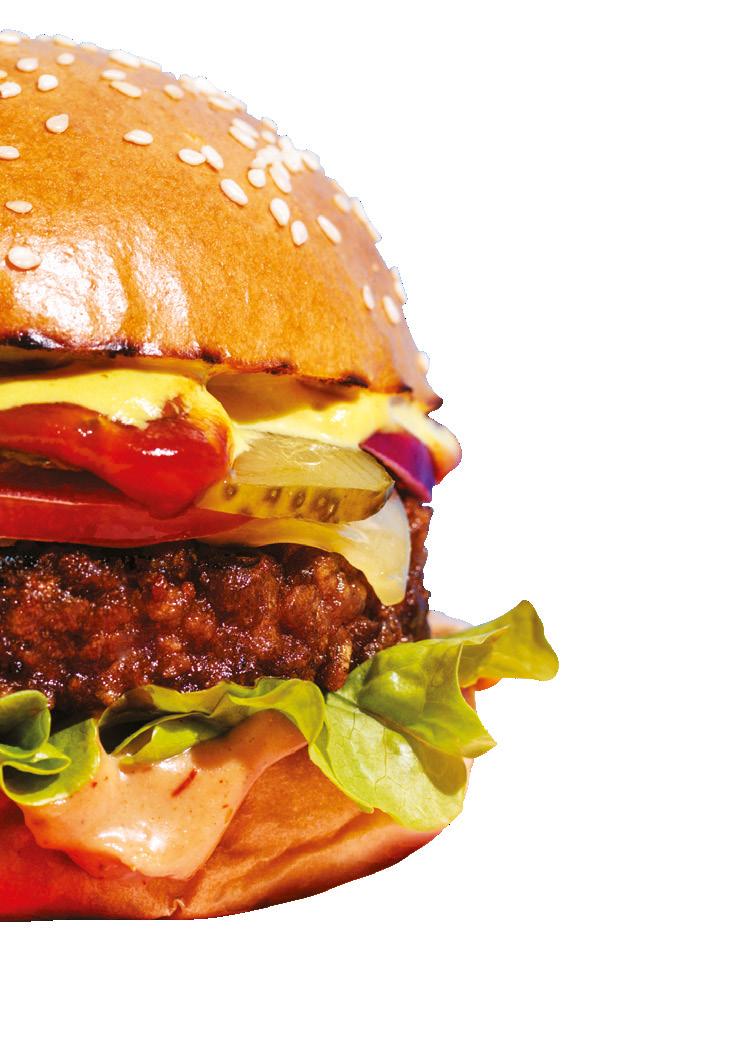

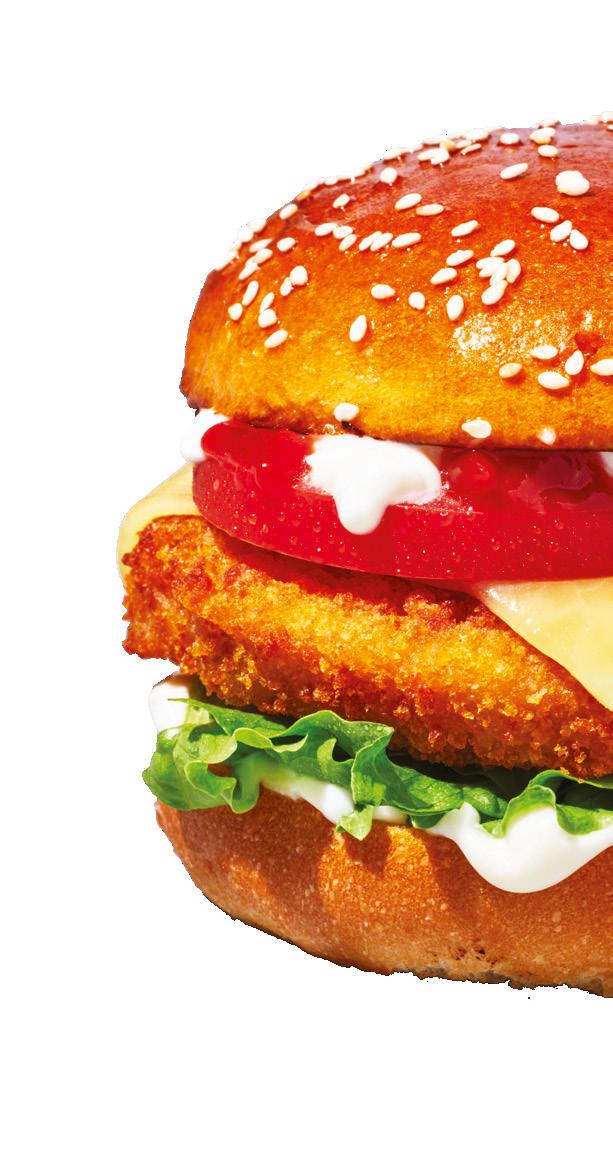

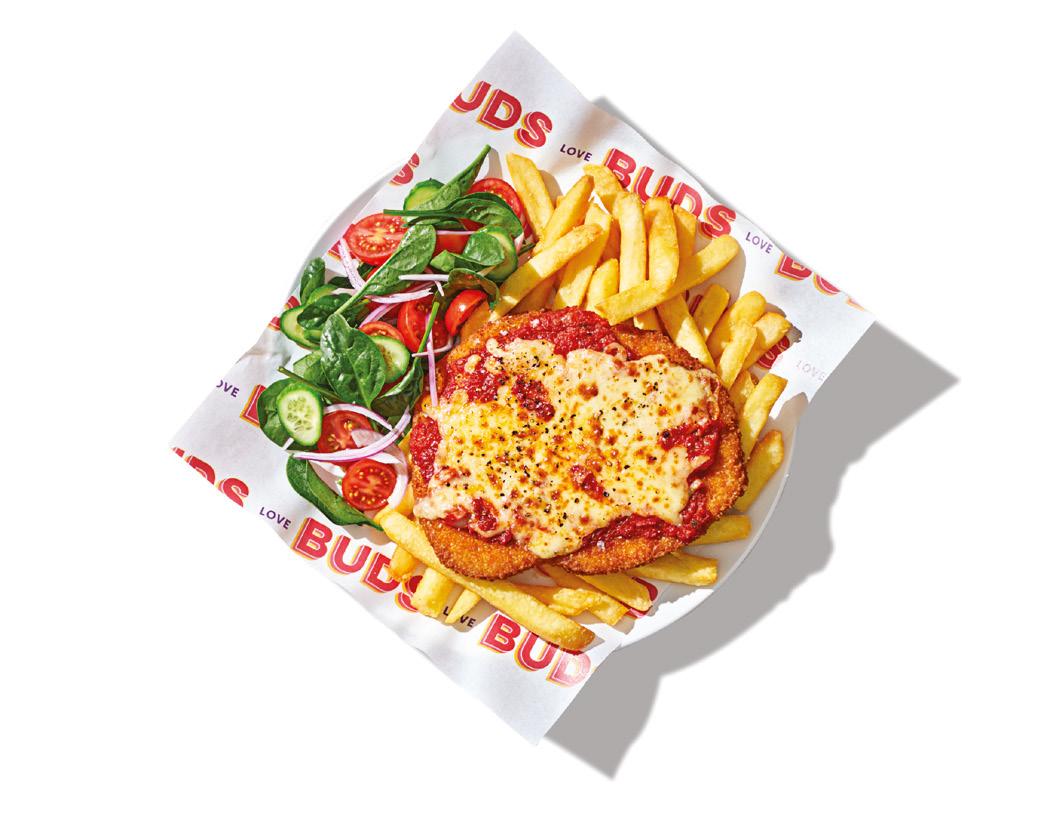

Juices are inherently plant-based and have played a significant role in the health and wellness movement. Cold-pressed juices are currently a popular option for both businesses and consumers and have versatility behind the bar and in the kitchen.


Unlike other methods of juicing, cold-press juice machines extract the nectar from fruits and vegetables through a hydraulic press. Most juices are made using centrifugal machines with spinning blades that can cause ingredients to oxidise and lose nutritional value.
Gary Dowse is known as a master juice chef and has penned more than 52 different coldpressed juice recipes. The juice chef says there’s much to think about when it comes to creating an unrivalled creation including selecting the right piece of equipment. “A cold-press machine squeezes and presses so you don’t get the oxygen and heat and you have more nutrition left in the juice,” he says. “It also tastes and looks better as it has a more vibrant colour.”
Other than delivering nutritional value to customers, cold-pressed juices are a convenient beverage option for businesses as they can be pre-bottled. “Most venues sell two to three times more volume if the juices are pre-bottled,” says Dowse. “You can dedicate an hour outside of service and make 30–50 bottles of cold-pressed juice a day that customers can grab and go.”

When it comes to creating recipes and juice combinations, Dowse recommends taking a seasonal approach. “You’re obviously not going to be juicing watermelon in the winter, but in summer it’s fantastic,” says the chef. “You can use citrus fruits in winter which are great because they’re high in vitamin C. Add in a bit of ginger and it’s a warming, nutritious and healthy winter drink.”
Dowse suggests combining a water-heavy fruit with herbs or root ingredients. “Normally, you use one ingredient with lots of water such as apple or cucumber and then add lemon, ginger, mint or parsley for flavour,” he says. “The thing to be aware of is not mixing red and green components because you end up with a brown-looking juice.”
Working out the right ratios is also a must. Dowse starts by making a 1-litre batch of juice before scaling up to larger quantities. “Then you just times it by two, five or 10,” he says.
Although cold-pressed juice is often consumed by itself, it can be used in other applications such as cocktails. “They’re extremely beneficial for bars,” says Dowse. “They have a vibrant colour and a really concentrated flavour, so you can use a lot less product.” There is no doubt cold-pressed juices play a crucial role in the plant-based sector. “People are looking to get more plants into their diet and one of the ways of doing that is having coldpressed juice.” ■


Can help repurpose food that would be wasted

The machine is a must-have in the kitchen and behind the bar.
Ideal for making garnishes
Simple and easy to use
Comes with stackable and removable shelves
Can be used for fruit and vegetables
Compact and lightweight
Temperature can be adjusted to achieve desired texture




The restaurateur reflects on 20 years of Icebergs and ushering in a new chapter for the Bondi establishment
How would you describe the 2023 Icebergs experience? We have worked very hard to maintain the DNA [through] some additions as well as restoring what was broken. The product at Icebergs was not broken, but we needed to attend to the elements in the venue that needed restoring. The experience has perhaps in a way become truer to the original vision: an invisible restaurant … almost like a private beach house for guests to feel something special.
The focus was to improve staff facilities to make service better with a new kitchen, cellar and waiter stations that really help our team serve more efficiently. Highlights [include] a new terrace dining area looking out at the Pacific Ocean and a dedicated seafood ice trough to showcase great produce. Finally, in a step closer to our sustainability program goals, we’ve welcomed the introduction of an induction cooking range in the kitchen.
How has the Italian/Australian food landscape evolved over the years?
I believe my work with Karen Martini at the Melbourne Wine Room and later Icebergs was the beginning of a movement of building an identity for Italo/Oz food. The orecchiette broccoli cavolfiore, the polenta chips, the lamb cutlets with hot fetta dressing — these dishes may feel normal now, but they were so ahead of their time back then. We weren’t just breaking the mould, we were creating a whole new one!
Describe your ultimate Icebergs experience Monty Koludrovic’s incredible selection of crudo followed by Orazio D’Elia’s spaghetti vongole, Alex Prichard’s beautiful lobster pasta and Jaci Koludrovic’s tiramisu. And anything from Karen’s first menu — those early days established Icebergs.
The crudo menu sings of seaside dining. In part, it is Japanese inspired, but the simplicity is very Italian. It’s the embodiment of my brief to the chefs (a brief that hasn’t changed in 20 years, except through the eyes of the chef at the helm): flavours my parents would recognise, but food they would never cook. There is something so special about eating seafood while looking out over the ocean from where it came from.
Of course, there’d be wine, something smashable, less alcohol and more fun. I have grown closer to smaller wine lists over the last few years — no one wants to look at a thesis of 10,000 wines! We’d probably drink a chilled red and there’d have to be a gimlet in there somewhere ... Lenny Opai is the king of the gimlet.
Where is your favourite place to sit in the restaurant?
I very rarely sit at a window table, they are for guests, so my favourite table has become 60. I am in amongst it all, I can see the staff, the guests and the movement of the restaurant while also having some privacy and a feeling of being protected by those glass waves. ■
Hostplus is a top-performing super fund that puts members first. That’s why we’re proud to have been named the 2023 Fund of the Year by third-party ratings agency SuperRatings. Judged across three areas: strong performance, competitive fees, and an ongoing focus on members, we’re thrilled to receive this recognition.




The rating is issued by SuperRatings Pty Ltd ABN 95 100 192 283 AFSL 311880 (SuperRatings). Ratings are general advice only and have been prepared without taking account of your objectives, financial situation or needs. Consider your personal circumstances, read the product disclosure statement and seek independent financial advice before investing. The rating and awards are not recommendation to purchase, sell or hold any product and are only one factor to be taken into account when choosing a super fund. Past performance information is not indicative of future performance. Ratings are subject to change without notice and SuperRatings assumes no obligation to update. SuperRatings uses objective criteria and receives a fee for publishing awards. Visit www.lonsec.com.au/superfund/ratings-and-awards/ for ratings information and to access the full report. © 2022 SuperRatings. All rights reserved. General advice only. Consider the relevant Hostplus PDS and TMD at hostplus.com.au and your objectives, financial situation and needs, which have not been accounted for. Awards and ratings are only one factor to consider. Host-Plus Pty Limited ABN 79 008 634 704, AFSL 244392 trustee for Hostplus Superannuation Fund, ABN 68 657 495 890. HP1973


Stoddart has built on the existing partnership with Giorik to utilise research & development to produce the unique, one of a kind, European styled modular 700 & 900 series cooking equipment to Australian Standards, delivering, efficiency, safety and reliability.

Giorik’s class leading, European design and engineering have been operating in the professional food service equipment industry since 1963.
Meeting the various needs of the global market,